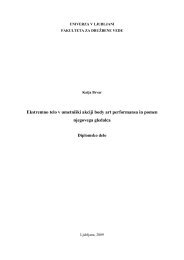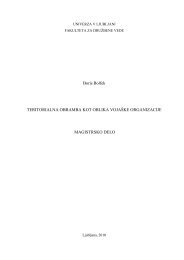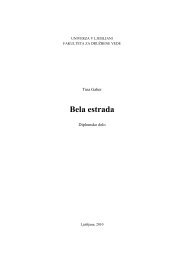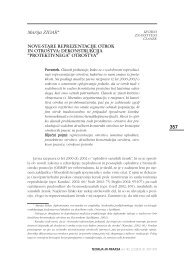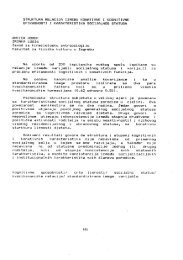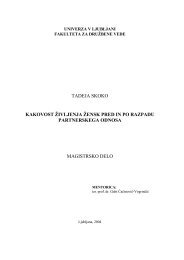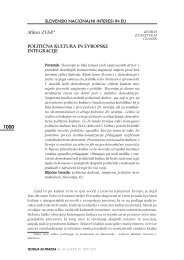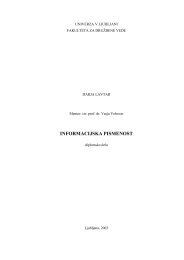Orientalism, dealing with the vast- ness of the Orient-Occident dichot ...
Orientalism, dealing with the vast- ness of the Orient-Occident dichot ...
Orientalism, dealing with the vast- ness of the Orient-Occident dichot ...
You also want an ePaper? Increase the reach of your titles
YUMPU automatically turns print PDFs into web optimized ePapers that Google loves.
<strong>with</strong> <strong>the</strong> traditional “evergreen” leftright<br />
cleavage typologisation whose<br />
very useful<strong>ness</strong> is questionable in<br />
current party and politico-ideological<br />
circumstances); 4) <strong>the</strong> system related<br />
one – that which includes <strong>the</strong> environmental<br />
and wider set <strong>of</strong> relevant<br />
input-output characteristics <strong>of</strong> a coalition<br />
and its processes, including <strong>the</strong><br />
mentioned value and trust aspects in<br />
area-specific circumstances, <strong>the</strong> role<br />
<strong>of</strong> political campaigns for explaining<br />
coalition behaviour etc.<br />
Although finishing this review<br />
<strong>with</strong> more general remarks on past,<br />
existing and possible future topics<br />
concerning coalitions, it can<br />
stated <strong>with</strong>out doubt that for all <strong>of</strong><br />
<strong>the</strong> abovementioned reasons <strong>the</strong> reviewed<br />
book is a valuable and welcome<br />
academic contribution to Slovenian<br />
scientific and o<strong>the</strong>r interested<br />
publics.<br />
Eva BATISTA<br />
Božidar Jezernik (ed.)<br />
Imagining ‘<strong>the</strong> Turk’<br />
Cambridge Scholars Publishing,<br />
Newcastle 2010, pp. 205, £39.99<br />
(ISBN 1-4438-1663-9)<br />
Theorization <strong>of</strong> <strong>the</strong> relationship<br />
between East and West has especially<br />
since <strong>the</strong> 1980s, <strong>with</strong> <strong>the</strong> initiation <strong>of</strong><br />
<strong>the</strong> post-colonial studies, been developing<br />
as a prominent <strong>the</strong>matic in<br />
all fields <strong>of</strong> arts and human sciences.<br />
The primary source <strong>of</strong> <strong>the</strong> postcolonial<br />
studies has been Edward Said’s<br />
<strong><strong>Orient</strong>alism</strong>, <strong>dealing</strong> <strong>with</strong> <strong>the</strong> <strong>vast</strong><strong>ness</strong><br />
<strong>of</strong> <strong>the</strong> <strong>Orient</strong>-<strong>Occident</strong> <strong>dichot</strong>omy,<br />
and thus <strong>the</strong> O<strong>the</strong>ring process.<br />
Identity formation is embedded in<br />
<strong>the</strong> dialectic relationship between<br />
positive and negative imagery. Positive<br />
features <strong>of</strong> our culture are chosen<br />
to depict our self-image, whilst<br />
<strong>the</strong> image <strong>of</strong> <strong>the</strong> o<strong>the</strong>rs is defined by<br />
<strong>the</strong> least attractive elements <strong>of</strong> <strong>the</strong>ir<br />
culture. The recently published volume<br />
Imagining ‘<strong>the</strong> Turk,’ edited by<br />
Božidar Jezernik, is <strong>dealing</strong> <strong>with</strong> <strong>the</strong><br />
dynamics <strong>of</strong> <strong>the</strong> O<strong>the</strong>ring process by<br />
exploring <strong>the</strong> relation between <strong>the</strong><br />
West and <strong>the</strong> Ottomans. It <strong>of</strong>fers <strong>the</strong><br />
understanding <strong>of</strong> <strong>the</strong> European past<br />
in relation to <strong>the</strong> Ottoman Empire.<br />
This version <strong>of</strong> <strong>the</strong> past, which is selectively<br />
constructed, is based on <strong>the</strong><br />
notion <strong>of</strong> exclusion and reflects on<br />
<strong>the</strong> political conditions, which enabled<br />
it. The image <strong>of</strong> ‘<strong>the</strong> Turk,’ as a<br />
ruthless plunderer, and <strong>the</strong> past to<br />
which it is related, is <strong>the</strong> one which is<br />
non-European, it is <strong>the</strong> negative side<br />
<strong>of</strong> <strong>the</strong> European self-image. This image<br />
proves to be still very much alive<br />
in <strong>the</strong> European collective conscious<strong>ness</strong>.<br />
By creating images, discourses<br />
and texts, <strong>the</strong> West appropriated ‘<strong>the</strong><br />
Turks,’ thus fixing and framing <strong>the</strong><br />
O<strong>the</strong>rs through essentialism. This<br />
concept was one <strong>of</strong> <strong>the</strong> key founding<br />
elements <strong>of</strong> <strong>the</strong> European or Western<br />
cultural identity.<br />
The volume is composed <strong>of</strong> fourteen<br />
papers, which are <strong>dealing</strong> <strong>with</strong><br />
<strong>the</strong>matically diverse topics, covering<br />
different areas and time periods. The<br />
papers are never<strong>the</strong>less intertwined<br />
<strong>with</strong> <strong>the</strong> prevailing <strong>the</strong>mes: <strong>the</strong> Oth-<br />
1107<br />
TEORIJA IN PRAKSA let. 47, 5/2010
1108<br />
threatening and horrible is fur<strong>the</strong>rmore<br />
explored by Özlem Kumrular<br />
in <strong>the</strong> paper The Creation <strong>of</strong> <strong>the</strong> Image<br />
<strong>of</strong> ‘<strong>the</strong> Turk’ in <strong>the</strong> 16 th century<br />
Mediterranean: Self-Reflection versus<br />
Antipropaganda. Kumrular names<br />
this phenomenon, which he traces<br />
in <strong>the</strong> works <strong>of</strong> Miguel de Cervantes<br />
and William Shakespeare, Turcophobia.<br />
Miha Pintarič in <strong>the</strong> paper Who<br />
are ‘<strong>the</strong> Turks’ <strong>of</strong> Panurge? demonstrates<br />
<strong>with</strong> <strong>the</strong> analysis <strong>of</strong> a part <strong>of</strong><br />
<strong>the</strong> renown book Gargantua and Pantagruel<br />
by François Rabelais, that ‘<strong>the</strong><br />
Turks’ culture is represented as <strong>the</strong><br />
upside down culture, <strong>the</strong> opposite<br />
<strong>of</strong> <strong>the</strong> Christian culture, signifying an<br />
extremely negative undertone. In <strong>the</strong><br />
paper Representations <strong>of</strong> ‘<strong>the</strong> Turk’ in<br />
<strong>the</strong> German Media from Early Modern<br />
Age to <strong>the</strong> Enlightment, Nedret<br />
Kuran-Burçoğlu discloses <strong>the</strong> ways in<br />
which <strong>the</strong> image <strong>of</strong> ‘<strong>the</strong> Turk’ was reshaped<br />
in German sphere over time<br />
due to changes in ideologies. By playing<br />
various roles, from admirable to<br />
threatening, ‘<strong>the</strong> Turk’ was shaped according<br />
to <strong>the</strong> current political needs.<br />
The relation between <strong>the</strong> national imaginary<br />
and <strong>the</strong> role, which ‘<strong>the</strong> Turk’<br />
has played in it, was elucidated by<br />
Peter Simonič in <strong>the</strong> paper Valvasor’s<br />
Hereditary Enemy. By focusing on<br />
Johann W.F. von Valvasor’s book Glory,<br />
Simonič reveals Valvasor’s racist<br />
and exclusionist vocabulary, despite<br />
<strong>of</strong> which, he has played a significant<br />
role in <strong>the</strong> Slovenian historical, social<br />
and national aware<strong>ness</strong>. Jale Parla<br />
in <strong>the</strong> paper From Byron’s Giaour<br />
to Jezernik’s Wild Europe: Theory or<br />
History explicates in <strong>the</strong> comparaering<br />
process, selective constructions<br />
<strong>of</strong> <strong>the</strong> past, <strong>the</strong> relation between<br />
West-Ottomans and Europe-Turkey,<br />
<strong><strong>Orient</strong>alism</strong>, nationalism, historical<br />
memory, cultural expressions, ideology<br />
and so forth. They are based on<br />
diverse analytical approaches, which<br />
are focused on specific examples <strong>of</strong><br />
historical, literary and o<strong>the</strong>r sources.<br />
The common findings <strong>of</strong> <strong>the</strong> analyses<br />
demonstrate that <strong>the</strong> roles <strong>of</strong><br />
both Europe and <strong>the</strong> Ottomans were<br />
crucial in <strong>the</strong> process <strong>of</strong> creation <strong>of</strong><br />
<strong>the</strong> image <strong>of</strong> ‘<strong>the</strong> Turk.’ The authors<br />
deconstruct <strong>the</strong> image <strong>of</strong> <strong>the</strong> O<strong>the</strong>r,<br />
but even more importantly, focus on<br />
<strong>the</strong> dynamics <strong>of</strong> <strong>the</strong> O<strong>the</strong>ring process<br />
itself. They reveal its meanings, implications<br />
and reappropriations over<br />
time, and thus give a new insight into<br />
<strong>the</strong> interpretations <strong>of</strong> <strong>the</strong> past as well<br />
as into <strong>the</strong> construction <strong>of</strong> European<br />
identity, alluding to <strong>the</strong> notion that<br />
‘<strong>the</strong> Turk’ has a permanent place in<br />
<strong>the</strong> European imaginary.<br />
Božidar Jezernik in <strong>the</strong> paper Imagining<br />
‘<strong>the</strong> Turk’ deconstructs <strong>the</strong><br />
stereotypical patterns <strong>of</strong> <strong>the</strong> image <strong>of</strong><br />
‘<strong>the</strong> Turk,’ rooted in <strong>the</strong> 15 th century<br />
Europe. This can be seen in <strong>the</strong> case<br />
<strong>of</strong> <strong>the</strong> construction <strong>of</strong> <strong>the</strong> Slovenian<br />
glorious past by historians, who reinterpreted<br />
<strong>the</strong> ‘Turkish wars’ at <strong>the</strong><br />
end <strong>of</strong> <strong>the</strong> 19 th and <strong>the</strong> beginning<br />
<strong>of</strong> <strong>the</strong> 20 th centuries. Rajko Muršič<br />
in <strong>the</strong> paper On Symbolic O<strong>the</strong>ring:<br />
‘The Turk’ as a Threatening O<strong>the</strong>r<br />
develops <strong>the</strong> <strong>the</strong>oretical framework<br />
for understanding <strong>the</strong> mechanisms<br />
<strong>of</strong> <strong>the</strong> O<strong>the</strong>ring process, which are<br />
a part <strong>of</strong> <strong>the</strong> collective imagery, i.e.<br />
habitus. The image <strong>of</strong> ‘<strong>the</strong> Turk’ as<br />
TEORIJA IN PRAKSA let. 47, 5/2010
tive analysis <strong>of</strong> <strong>the</strong> two works that<br />
<strong>the</strong> methodological link between<br />
history and <strong>the</strong>ory is necessary for<br />
any research, in order for it to show<br />
how social inventions <strong>of</strong> o<strong>the</strong>r<strong>ness</strong><br />
are conditioned by <strong>the</strong> ideologicalhegemonic<br />
discourses <strong>of</strong> sovereignty<br />
in <strong>the</strong> formulations <strong>of</strong> domestic<br />
policies and international relations.<br />
Bojan Baskar in <strong>the</strong> paper ‘The First<br />
Slovenian Poet in a Mosque’: <strong><strong>Orient</strong>alism</strong><br />
in <strong>the</strong> Travel Writing <strong>of</strong> a Poet<br />
from <strong>the</strong> Imperial Periphery detects<br />
in <strong>the</strong> travel writing <strong>of</strong> <strong>the</strong> Slovenian<br />
poet Anton Aškerc patterns <strong>of</strong> <strong>the</strong><br />
Slovenian variety <strong>of</strong> frontier <strong><strong>Orient</strong>alism</strong>.<br />
The latter is a kind <strong>of</strong> lamentation<br />
over <strong>the</strong> Turkish raids, and<br />
played <strong>the</strong> central role in <strong>the</strong> Slovenian<br />
national narrative during <strong>the</strong><br />
19 th century. Alenka Bartulović discloses<br />
that <strong>the</strong> myth <strong>of</strong> <strong>the</strong> Ottoman<br />
incursions is still an important part<br />
<strong>of</strong> Slovenian national memory, a case<br />
<strong>of</strong> <strong>the</strong> nationalised past, in <strong>the</strong> paper<br />
‘We Have an Old Debt <strong>with</strong> <strong>the</strong> Turk,<br />
and It Best Be Settled: Ottoman Incursions<br />
through <strong>the</strong> Discursive Optics<br />
<strong>of</strong> Slovenian Historiography and Literature<br />
and Their Applicability in <strong>the</strong><br />
Twenty-First Century. Nazan Aksoy<br />
<strong>of</strong>fers an insight into <strong>the</strong> Ottomans’<br />
gaze at <strong>the</strong> West in <strong>the</strong> paper The O<strong>the</strong>rs<br />
in <strong>the</strong> Early Turkish Novel, where<br />
Aksoy elucidates <strong>the</strong> ambivalent attitudes<br />
<strong>of</strong> <strong>the</strong> Turkish intellectuals<br />
towards westernisation and its consequence,<br />
which felt would undermine<br />
<strong>the</strong> traditional values <strong>of</strong> <strong>the</strong> Ottoman<br />
society. Aleksandra Niewiara in <strong>the</strong><br />
paper ‘The Dear Neighbour,’ that ‘Vicious<br />
Murderer’: Imaging <strong>the</strong> Turk in<br />
Polish Language and Culture, deals<br />
<strong>with</strong> <strong>the</strong> past and present image <strong>of</strong><br />
<strong>the</strong> Turk in Polish culture, pointing<br />
out that <strong>the</strong> Turkish people are symbolically<br />
indispensable for Polish, as<br />
<strong>the</strong>y are intertwined <strong>with</strong> <strong>the</strong>ir myths,<br />
history and culture. Bülent Aksoy in<br />
<strong>the</strong> paper Music among <strong>the</strong> Ottomans<br />
through Western Eyes is concerned<br />
<strong>with</strong> <strong>the</strong> European attitude towards<br />
<strong>the</strong> Ottoman music during <strong>the</strong> 15 th<br />
and 19 th centuries, which acted as a<br />
means <strong>of</strong> <strong>the</strong> O<strong>the</strong>ring process and<br />
was later as such used by Turkey,<br />
which o<strong>the</strong>red Ottoman music by excluding<br />
it from <strong>the</strong> concept <strong>of</strong> national<br />
culture. The relation between European<br />
and Turkish elements in music<br />
is fur<strong>the</strong>rmore explored in Svanibor<br />
Pettan’s paper The Alaturka-alafranga<br />
Continuum in <strong>the</strong> Balkans: Ethnomusicological<br />
Perspectives. Ayhan<br />
Kaya in <strong>the</strong> paper The Age <strong>of</strong> Securitisation:<br />
Challenging Multiculturalist<br />
and Republicanist Policies <strong>of</strong> Integration,<br />
elaborates on <strong>the</strong> process <strong>of</strong> securitisation<br />
<strong>of</strong> migration and Islam in<br />
<strong>the</strong> West, claiming that <strong>the</strong> policies <strong>of</strong><br />
integration proved to have failed in<br />
politically mobilising migrants and<br />
<strong>the</strong>ir descendants.<br />
The volume represents a part <strong>of</strong><br />
<strong>the</strong> critical academic discourse <strong>of</strong><br />
<strong>the</strong> phenomenon <strong>of</strong> <strong>the</strong> O<strong>the</strong>ring<br />
process found in East-West relation,<br />
which is intertwined <strong>with</strong> <strong>the</strong> process<br />
<strong>of</strong> identification, <strong>the</strong> notion <strong>of</strong><br />
culture and selective (re)construction<br />
<strong>of</strong> <strong>the</strong> past. Thematically it relates to<br />
<strong>the</strong> premise <strong>of</strong> post-colonial studies,<br />
exploring <strong>the</strong> O<strong>the</strong>ring process<br />
and <strong>the</strong> East-West relation through<br />
1109<br />
TEORIJA IN PRAKSA let. 47, 5/2010
1110<br />
three major concepts: (post)nationalism,<br />
<strong>the</strong>ory and cultural expressions,<br />
such as music and literature. The relation<br />
between <strong>the</strong> image <strong>of</strong> ‘<strong>the</strong> Turk’<br />
and nationalism is brought to <strong>the</strong><br />
fore by papers <strong>of</strong> Božidar Jezernik,<br />
Peter Simonič, Bojan Baskar, Alenka<br />
Bartulović, Nedret Kuran-Burçoğlu,<br />
Aleksandra Niewiara and Ayhan<br />
Kaya. Jezernik, Baskar, Simonič and<br />
Bartulović address <strong>the</strong> issue in <strong>the</strong><br />
Slovenian national context, <strong>the</strong> first<br />
three by exploring <strong>the</strong> reappropriations<br />
<strong>of</strong> history, whilst Bartulovič<br />
makes a connection to <strong>the</strong> national<br />
context <strong>of</strong> <strong>the</strong> present-day. Kuran-<br />
Burçoğlu addresses <strong>the</strong> issue in <strong>the</strong><br />
past German national context, whilst<br />
Niewiara looks at <strong>the</strong> Polish national<br />
context now and in <strong>the</strong> recent history.<br />
Kaya stands out by considering<br />
<strong>the</strong> most actual situation, <strong>the</strong> status <strong>of</strong><br />
<strong>the</strong> Turks in EU, i.e. Euro-Turks, proposing<br />
that migration issues should<br />
be desecuritised. Theory is most<br />
acutely addressed in <strong>the</strong> papers <strong>of</strong><br />
Rajko Muršič, who discuses <strong>the</strong> notion<br />
<strong>of</strong> <strong>the</strong> O<strong>the</strong>r as a threat through<br />
<strong>the</strong> concepts <strong>of</strong> structure and agency<br />
as well as alterity, lining out that <strong>the</strong><br />
process <strong>of</strong> O<strong>the</strong>ring itself is important<br />
and not simply <strong>the</strong> result <strong>of</strong> it,<br />
<strong>the</strong> O<strong>the</strong>r, and Jale Parla, who by analysing<br />
<strong>the</strong> romantic <strong><strong>Orient</strong>alism</strong> <strong>of</strong><br />
Lord Byron and Božidar Jezernik’s<br />
study <strong>of</strong> Balkan as <strong>the</strong> O<strong>the</strong>r <strong>of</strong> Europe,<br />
points out to <strong>the</strong> necessity <strong>of</strong><br />
<strong>the</strong> methodological linkage between<br />
history and <strong>the</strong>ory. Analyses <strong>of</strong> literature<br />
as Western cultural expressions<br />
<strong>of</strong> <strong>the</strong> O<strong>the</strong>ring process are accomplished<br />
by Özlem Kumrular, Miha<br />
Pintarič, Jale Parla and Nazan Aksoy,<br />
whereas <strong>the</strong> image <strong>of</strong> <strong>the</strong> o<strong>the</strong>r is explored<br />
as well in <strong>the</strong> music genre by<br />
Bülent Aksoy and Svanibor Pettan.<br />
The volume’s research topic is <strong>of</strong><br />
great present interest, considering<br />
<strong>the</strong> present problematic <strong>of</strong> <strong>the</strong> EU<br />
politics and legislation on migration<br />
and <strong>the</strong> never-ending debates on Turkey’s<br />
joining <strong>of</strong> <strong>the</strong> EU. The volume<br />
explicates that <strong>the</strong> former relation between<br />
<strong>the</strong> West and <strong>the</strong> Ottomans is<br />
reflecting in <strong>the</strong> present-day relation<br />
between Europe and Turkey. Therefore,<br />
it discloses that <strong>the</strong> image <strong>of</strong> ‘<strong>the</strong><br />
Turk’ has, does and will continue to<br />
shape <strong>the</strong> self-image <strong>of</strong> Europe, by<br />
being altered according to changes<br />
in politico-ideological circumstances.<br />
The volume sets out to break down<br />
<strong>the</strong> unified stereotypical image <strong>of</strong><br />
‘<strong>the</strong> Turk,’ although <strong>the</strong> papers are<br />
not equal in <strong>the</strong>ir depth and rich<strong>ness</strong>,<br />
some needing a deeper intake.<br />
Never<strong>the</strong>less, <strong>the</strong> volume as a whole<br />
represents a valuable contribution to<br />
<strong>the</strong> studies, <strong>dealing</strong> <strong>with</strong> culture and<br />
identity in East-West relation.<br />
TEORIJA IN PRAKSA let. 47, 5/2010




